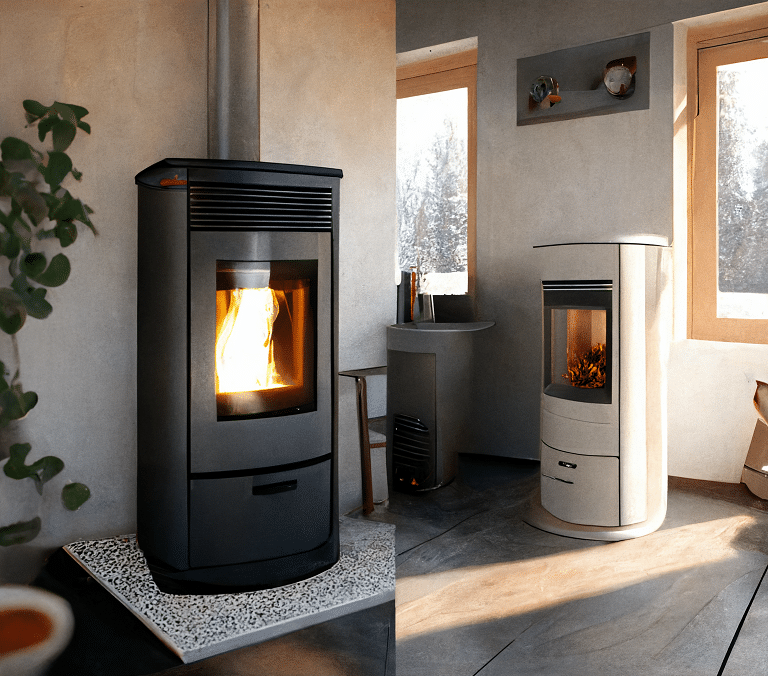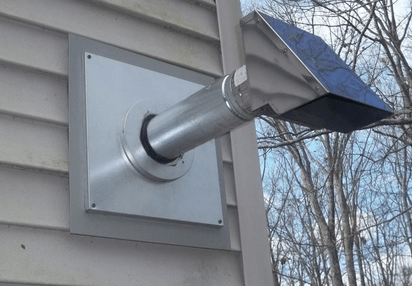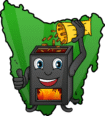You’ll often see pictures online showing pellet heaters without any visible flue or chimney. So people naturally wonder do pellet heaters need a flue? Some websites also talk about “direct venting” which, coupled with pictures that show no flue or chimney, leads people to think pellet heaters can be installed without a flue. Unfortunately this isn’t true. Pellet heaters absolutely need a flue or chimney. Even though they burn much cleaner and basically produce no visible smoke (read my eco friendly pellet heater post if you haven’t yet), they still burn wood in the form of pellets which produces emissions that must be vented outside of the building they are installed in.

Pellet heaters need a flue and can be vented in the following two ways. Read on below to find out the difference and don’t forget that if you are planning to buy a pellet heater speak to the retailer about which venting option would work best for your house and the location you want the pellet heater to go in:
- Wall vented: Cheaper installation, but requires external wall placement.
- Ceiling vented: Similar to wood heater. Usually more expensive than venting through a wall.
What Kind of Chimney Does a Pellet Heater Use?
Pellet heaters don’t use a chimney. If you have an old brick chimney you won’t be able to vent the pellet heater directly into the chimney. Pellet heaters use a metal flue, which is basically a metal pipe that connects to the pellet heater and then vents emissions outside your house. If you do have an old chimney then you would connect a flexible flue pipe to get inside of the chimney and then run a standard flue pipe inside the chimney to the outside. I know some people use chimney when they really mean flue and it doesn’t really matter. However, technically there is a difference between the two and pellet heaters use a flue, not chimney.
What’s a Pellet Heater Wall Vent?
Even though pellet heaters need a flue, one big advantage pellet heaters have over wood heaters is how the flue can be installed. The first option, which is the same as a wood heater, is up through the ceiling and roof of the house. While the flue size diameter is different for a pellet heater, it’s a bit smaller, they are still installed the same way as a wood heater and vent out through the ceiling of the room they are in then the roof of the house. However, pellet heaters can also be vented through a wall, such as the wall directly behind it. That’s why you see so many pictures of pellet heaters online without a visible flue.

The main advantage of venting through a wall is it is cheaper, simpler, and quicker to install than going through the roof. It’ll cost less to install a pellet heater through the wall behind it than you would going through the roof. Some people also like the idea of not having to cut a hole in their roof for the flue. Once outside, the flue can either point down to the ground or extend up higher so it vents up away from the ground into the open air, avoiding any issues hot air blowing at the ground outside may cause. Venting through the wall may also mean your pellet heater heats your house better due to where you’ve placed it.
How Else Is a Pellet Heater Flue Installed?
Besides a wall vent, the other way to vent a pellet heater is to run the flue up through the ceiling of the room it is installed in and then through the roof of your house. If you’ve owned a wood heater in the past or seen them on houses where you live, then you’ll be familiar with the metal wood heater flue sticking out the roof of a house. This is the more traditional way of installing a heater but the downside is cost and time. It will cost more as the flue usually is longer than venting through the wall behind the pellet heater and you have to cut more holes, so it requires more labour to install.
Keep in mind that how a pellet heater is vented, wall or through the ceiling will also depend on the model. Most pellet heaters vent out the back, so can go through the wall or up and through the ceiling easily. However, some European brands, like Piazzetta or Palazzetti have “top venting”. This means they look like a wood heater with the flue coming up the top of pellet heater. These models are more suited to installing through the ceiling due to the location of the exhaust port. You can still vent out the wall but it would look a bit odd. Check with your pellet heater retailer about venting options for the model of heater you want to buy.
What’s the Difference Between Wall and Ceiling Flue Installation?
Besides cost to install and aesthetics, the main difference between venting directly through a wall or going through the roof of a house would be the amount of natural draft, which is only important during blackouts. Wood heaters do not use an exhaust fan to vent smoke and other emissions outside of your house. The draft created by the flue causes hot air to vent up and out of the wood heater. Even when you open the door on a wood heater this draft will prevent most smoke from billowing out into the room it is installed in. The length of the flue creates this draft, so wood heater flues must be a minimum length to ensure this draft exists.
Pellet heaters, however, use a fan to vent emissions outside and if installed through the wall the flue pipe may not have much vertical draft because it is short, at least compared to a wood heater flue. This isn’t a problem for a pellet heater because the fan pushes the air out. Pellet heaters don’t need natural draft because of the exhaust fan. However, if the power goes out, then the exhaust fan stops blowing air out the flue. If this happens, then there may not be enough natural draft to suck air out the flue, which will cause smoke to come out of the pellet heater into the room.
This is where the difference between a traditional flue installed through the roof and going through the wall comes into play. Installing a pellet heater flue through the roof of your house will most likely mean there’s some length to the flue, much like a wood heater. It’s this length of the flue pipe that creates the natural draft. So, if the power goes out and the exhaust fan stops running, then the smoke in your pellet heater will still vent outside because of the vertical draft created by the flue pipe.
If, however, the pellet heater is installed through the wall, the flue pipe may be very short and not have much vertical length, so there won’t be as much natural draft. If the power goes out, the smoke in your pellet heater won’t move as easily up and out the flue because it is shorter and there isn’t as much draft. This is where people have problems with smoke entering the room the pellet heater is installed in because the smoke can’t go out the flue naturally without the exhaust. This is also one of the reasons you should use a pellet heater UPS so if the power goes out you won’t have this problem.
How Long Should a Pellet Heater Flue Be?
As mentioned above, the more vertical length you have on a pellet heater flue the more natural draft there will be. This is important only if the power goes out. What the minimum length is will depend on the pellet heater model but generally speaking around 1.5m or so is the recommended length to get sufficient draft. How long a pellet heater flue can be also depends. In a normal setup once you get to around 10m you are reaching the maximum length. However, extra length can be used if you install an additional exhaust fan.
Pellet heaters, unlike wood heaters, use an exhaust fan to keep the fire burning and that’s why there’s a maximum flue length. If the flue is too long, the exhaust can’t push air through your pellet heater and out the flue. This is why for very long flues they install a second fan. This second fan continues to push air out the flue so the pellet heater can burn efficiently. It’s highly unlikely you’ll need a setup like this and not all pellet heater installers will do this. If you live in a multistory house and want to run the pellet heater flue out the chimney that extends 3 stories or something, then you’ll probably need a setup like this.
Which Type of Flue is Easier to Clean?
Pellet heaters need to be deep cleaned at least once a year, including the flue. Cleaning the flue on a pellet heater is the same as cleaning a wood heater flue but considerably easier because you don’t get the same type of creosote buildup with wood pellets as you do with firewood. That’s because pellets contain much less moisture and burn cleaner. Cleaning the flue on a pellet heater involves taking the T cap off and running a flue brush up the pipe to get out all the ash. It’s much easier than a wood heater flue because there’s mostly ash inside the flue, which is easier to clean out than hard residue build up you get with wood heaters.
The easiest type of flue to clean would probably be a direct vent through the wall flue. This is due to two reasons. First, wall vented flues are usually short or at least shorter than ceiling vented flues. That means you won’t have to run your flue brush through as much pipe and it will be quicker and easier to clean. Secondly, wall vent flues are closer to the ground. Many vent directly outside, so you can easily gain access and even clean the cowl on the flue without having to climb up onto a roof. If you can vent through the wall or ceiling and plan do to your own servicing and cleaning, keep this in mind.
Pellet Heater Venting Summary
Despite burning much cleaner and almost being smoke free, pellet heaters still need to be installed with a flue. This flue can go through the roof of your house like a traditional wood heater or directly through the wall behind the pellet heater and vent straight outside. Venting through the wall is perfectly safe, much cheaper, and easier to install than going through the roof of a house. This also means that you may be able to make better use of space in your house, because being able to vent through the wall means you can put the pellet heater in a corner and vent through the wall much easier than you could with a wood heater.
Resources
Wood and Pellet Heating
